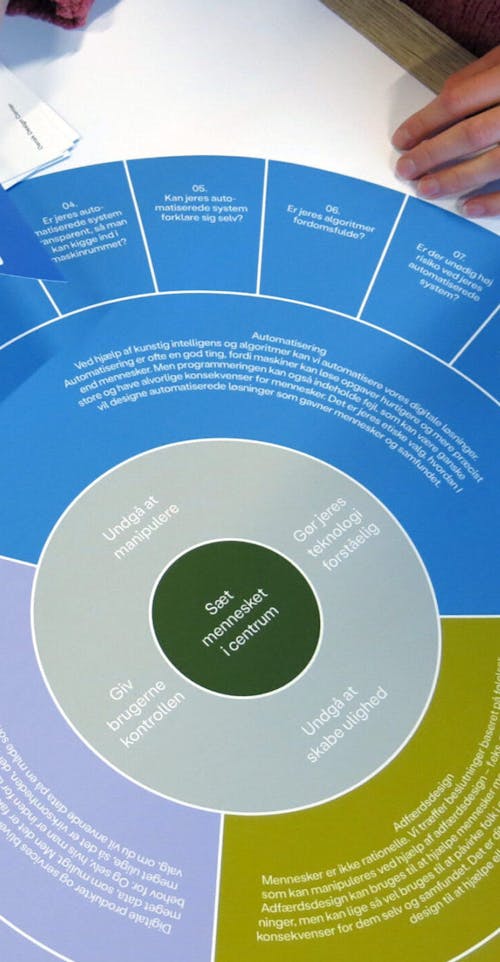
Log 10: Methods for Ethical Learning
28. Jan 2022Ethics is not really a subject that can be taught on a blackboard, and therefore we have studied a large number of other methods for teaching ethics.
By Peter Svarre
This article is published in connection with The Digital Ethics Compass project.
In The Digital Ethics Compass project, we have worked with and studied different methods of teaching people to be more aware of ethics when working with digital designs. Here is a summary of seven of the most interesting methods:
Provocatyping is, as the name suggests, a variant of prototyping where instead of building the optimal prototype, the design team is instead tasked with making the absolute most unethical, misanthropic, or socially damaging prototype of a product. In order for the exercise to make sense, it is important, however, that the product still has value for those who buy it.
In a few of our workshops, we asked the participants to design both the most unethical and the most ethical version of a rifle that they could imagine – with the condition that the rifle should still be functional and useful for whoever buys it. The exercise resulted in some very interesting considerations about what makes rifles functional, user-friendly, ethical, and unethical. One of the conclusions was that a bit of friction in the design of the rifle can often contribute to making it more ethical.
The ethical bell is a game where players must extremely rapidly assess a lot of digital designs and products and then press a button ringing a bell if they get a gut feeling that there is something unethical about it. Subsequently, the players can discuss in groups why the bell was rung and why it was rung by some participants but not others.
The dilemma card exercise is somewhat similar to the ethical bell exercise, but here it is about diving deep into a realistic dilemma that the design team might face in their daily work. The dilemma is described on a physical card (the tactile element makes it more real) and the participants discuss the ethical pros and cons and try to work together to come up with a solution. Dilemma cards can also be used with the next exercise.
The three hats exercise involves the participants examining a specific ethical design dilemma, but instead of letting the design team discuss it freely, they are made to wear three hats that symbolize different schools of ethical thought (they don’t actually need to wear physical hats). We have used these three hats, but one can of course choose other schools of ethical thought and other philosophers:
- The ethics of duty – symbolized by Immanuel Kant
- The ethics of consequence – symbolized by John Stuart Mill
- The ethics of virtue – symbolized by Aristotle
The exercise is a kind of roleplaying game that typically has the advantage of forcing the participants to think outside of their own little box and see the problems from another angle.
Roleplay can be used in slightly larger exercises too, where for example one asks the design team to design an entirely new product in one hour. As the game progresses, participants can be assigned different roles that end up conflicting with each other which creates ethical dilemmas. For example, one participant may be told to focus on profit and a quick launch while another participant is told to focus on the ethics of duty.
Futuring is an exercise that uses methods from future research. The aim is to get the participants to look to the future and imagine the ethical consequences of their designs. For example, this can be done by having them work with different scenarios for how the product, users, and the world develop. The goal is to get the design team to look past their day-to-day lives and begin to imagine the big picture issues with their solutions. The goal is not to correctly predict any future event, it is rather to create doubt and encourage thoughtfulness.
Sci-fi writing is a method that we have not yet tested in this project, and it probably also requires the participants to put in a little more work. The idea is that the design team participants write a dark sci-fi novel where the story revolves around all of the unfortunate and unintended consequences of digital design. The goal is the same as in the futuring exercise, but sci-fi writing is better suited as a homework assignment for the individual designers and the result can be quite entertaining and engaging if the participants take it seriously.
There are of course also many other methods that can be used to teach ethics – and our project team is very open to considering new ideas and experiences. You can read about other methods here.

Can’t get enough of design and innovation? We hear you. And we have you covered.
Sign up for our newsletter to get the latest from our world delivered straight to your inbox.
Sign up for the ddc newsletter











